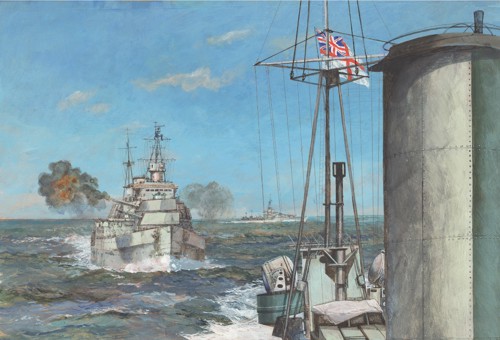
Today we're showing three pieces of artwork from our November 2023 series books! Let us know in the comments which books you'd like to see featured in our December 2023 Artwork Reveal!
The Winter Campaign in Italy 1943: Orsogna, San Pietro and Ortona
By Pier Paolo Battistelli
Illustrated by Johnny Shumate

A COMPANY, US 753RD TANK BATTALION ON THE ROAD TO SAN PIETRO INFINE, 15 DECEMBER 1943
By late afternoon on 15 December, it was clear that A Company, US 753rd Tank Battalion’s attack against San Pietro was facing failure. The three tanks that, moving along the road, had reached the town had been destroyed by the Germans; all the others (apart from one, which made its way back) had been disabled by mines, or in their attempts to move along the road, or off it by negotiating the steep terraces to their right. Close to the track leading to the terrace, tank No. 13 was instructed by the platoon leader to move along the track and, while attempting to do so, it threw a track. It was the culmination of a series of unfortunate events, with tank No. 12 overturning while negotiating the terrace, and, while moving along the main road, tank No. 11 slipping off the road and falling into the embankment and overturning. Tank No. 9, farther down the road, had in the meantime become immobilized while attempting to negotiate the stone wall leading to the terrace. Luckily, tank No. 13 was accidentally hit by the company commander’s tank, No. 10, as it backed up the road, which put tank No. 13 back on its track. The company commander then ordered tank No. 13 to remain in position and to provide cover fire against San Pietro during his attempt to outflank the town defences from the north along with tanks nos. 14, 15 and 16. The attempt failed, but tank No. 13 fulfilled its mission and was amongst the four Shermans (out of 16) that would make their way back to the starting line. Of the 12 Shermans disabled on the San Pietro Infine road, only five could be recovered after the Germans abandoned the town on 17 December.
Requested by Alex Fernández
British Pacific Fleet 1944–45: The Royal Navy in the downfall of Japan
By Brian Lane Herder
Illustrated by Paul Wright

SHELLING SAKASHIMA GUNTO, 4 MAY 1945
On 4 May 1945, Rawlings detached a major surface force to shell the Sakashima Gunto airbases. Rawlings believed heavy battleship and cruiser gunfire could more thoroughly suppress the Japanese anti-aircraft batteries. The force detached from the carriers at 1000hrs. Commanded directly by Rawlings, it included battleships King George V and Howe, Minotaur-class light cruiser HMS Swiftsure, Dido-class light cruisers HMS Black Prince and HMS Euryalus, Fiji-class cruisers HMCS Uganda and HMNZS Gambia, and the six destroyers of the 25th Destroyer Flotilla: HMS Grenville, HMS Ursa, HMS Undine, HMS Urchin, HMS Urania and HMS Undaunted. The force was provided with its own fighter CAP, as well as designated fighters for shell spotting.
The force was in position at 1155hrs and commenced the shelling at 1205hrs. The battleships opened fire on Hirara and Nobara airfields at 25,000 yards, while the cruisers opened up from between 17,000 and 18,000 yards. King George V and Howe combined to unload 195 14in shells and 378 5.25in shells at the enemy installations. The five cruisers expended 598 6in and 378 5.25in rounds in total. This scene focuses on the two Fiji-class cruisers, the Royal Canadian Navy’s HMCS Uganda and the Royal New Zealand Navy’s HMNZS Gambia. The two cruisers have their 6in turrets swung out to broadside and are bombarding from about 15,000 yards range. They are cruising at about 15 knots.
Almost immediately, Rawlings became aware that kamikazes had crashed two of his carriers over the horizon. Visibly upset, Rawlings did not abort the shelling but ordered his ships to complete the mission as quickly as possible. At 1247hrs the surface force retired back towards the carriers at 25 knots.
Artwork requested by Daniel Figueroa Giraldez.
Valentine Infantry Tank vs Panzer III: North Africa 1941–43
By Bruce Newsome
Illustrated by Adam Hook

The Battle for Tebourba, Tunisia, 1 December 1942.
Requested by Mark L.

Comments
You must be logged in to comment on this post. Click here to log in.
Submit your comment